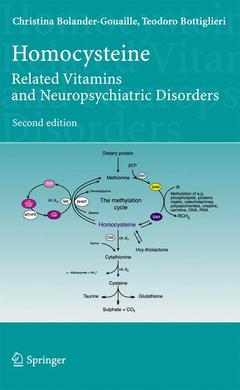Homocysteine (2nd Ed., 2nd ed. 2007) Related Vitamins and Neuropsychiatric Disorders
Langue : Anglais
Auteurs : Bolander-Gouaille Christina, Bottiglieri Téodoro

During the last 15 years the research on homocysteine and the vitamins involved in its metabolism has become very dynamic. About 1,500 publications on the subject are now published each year. The research has long mainly focused on the association between homocysteine and cardiovascular disease, but also pregnancy complications/ fetal malformations. There is, however, an increasing interest in the connection between the homocysteine metabolism and neuropsychiatric disease with a steeply increasing number of publications. In particular, the association between homocysteine metabolism and cognitive decline/dementia attracts much interest. If simple, non-toxic homocysteine-lowering treatment with vitamins can reduce the incidence of, or delay the onset of dementia, it would have an enormous impact in societies with a rapidly increasing number of elderly at risk for dementia. This book summarises the research within the neuropsychiatric field, but also gives an overview of the underlying biochemistry and of diagnostic aspects. About 1,000 references are given. Christina Bolander-Gouaille, a pharmacist, has for over 10 years specialised in writing reviews/monographs on homocysteine and related vitamins. This is her third book in a series edited by Springer Verlag. This book, however, is written in collaboration with Teodoro Bottiglieri, who is director of neuropharmacology and senior research scientist at Baylor University, Institute for Metabolic Diseases in Dallas, USA.
Acknowledgements Introduction.- What is homocysteine?.- The homocysteine metabolism;The methylation cycle;Common enzyme defects.- How can hyperhomocysteinaemia be neurotoxic?; Vascular damage;Other mechanisms.- Why do homocysteine levels increase?; Lifestyle factors; Age-related factors; Hormonal changes; Diseases; Drugs.- Neuropsychiatric conditions associated with hyperhomocysteinaemia; Stroke;Cognitive impairment/dementia; Depression; Other neuropsychiatric disorders.-Impact of common enzyme defects on neuropsychiatric conditions; Stroke; Cognitive impairment/dementia; Depression; Other neuropsychiatric disorders; Interactions with drug treatment.- When and how to check the homocysteine levels .- When can hyperhomocysteinaemia be suspected?; Blood sampling; Methionine loading.- How to interpret the test result and how to handle hyperhomocysteinaemia.- Reference ranges.- Abbreviations
Date de parution : 02-2007
Ouvrage de 217 p.
15.5x23.5 cm
Épuisé
Thèmes de Homocysteine :
© 2024 LAVOISIER S.A.S.



